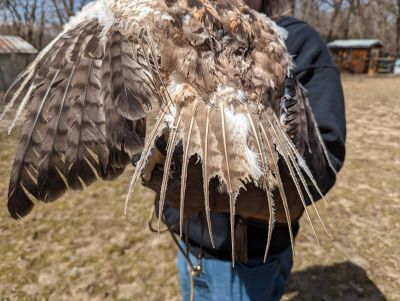
Good Naured: Risks for Young Raptors
Alrighty Good Natured readers, show of hands: As a child or young adult, how many of you learned at least one lesson the hard way?
When you think about it, unpleasant consequences are one of THE BEST ways to ensure you don't make the same mistake twice. I, for instance, have just one scar on my knee earned by roller skating into a parked car, because one time was all it took to learn what a really dumb idea that is. Ditto for jumping off a garage roof (scar on thigh); kissing a macaw (scar on lip); and eating a smoldering marshmallow fresh from the campfire flame. (No scar for that one, but a lasting memory of searing pain I'll likely never forget.)
So it is with wildlife, too. Only for these creatures learning the hard way might also be a matter of life or death. Consider a frog that opts to exit its breeding pond right next to where a hungry garter snake is camouflaged. Or an opossum that picks an inopportune time to cross a road.
Or the extreme risks young raptors face trying to find enough food to survive. Mortality rate estimates for first-year birds of prey range from 50% to 80%.
Red-tailed hawks, for instance, typically hunt small rodents as their first prey items—with good reason! They're abundant and relatively easy to catch unawares. But what happens if there's a heavy snow that first winter? Some young hawks figure out how to look and listen for signs of movement under the thick white blanket…and some don't. Some find slow-moving prey…and perish from rodenticide poisoning. Some turn to feeding on roadkill…and become roadkill themselves.
Then we have those that discover the bounty of prey that live in the open space surrounding--get this--landfills. The real estate surrounding these gargantuan operations isn't particularly well suited to housing developments, so it's typically covered in grasses and shrubs--which provide habitat for all sorts of critters. Voles, mice and shrews, ground squirrels, rabbits, opossums and skunks are just a few of the animals that have been noted to occur in these large buffer areas.
Sounds like an ideal buffet for a bird of prey, doesn't it? And it is! But there's a problem. While the offerings are basically all you can eat, the area comes with an inherent risk: methane flares, the exhaust pipes that burn off the methane produced as organic materials in the landfill decompose.
You've probably seen these stacks, and if you pass by a landfill at night you might have even seen their flames. But in the daytime these blazing burners can be very hard to see. Compounding the problem is that some of these flares operate intermittently; one minute they look like a safe place to perch and the next they're spewing fire.
Can you see where this is going?
Diurnal or daytime birds of prey intent on hunting can fly right into the flare, and are quickly converted from a majestic soaring raptor to a grounded lump of charred feathers. Similarly, a raptor that opts to land on a stack can--whoosh!--erupt into a horrific ball of flames as its feathers ignite.
How widespread is this problem? It's hard to say. In fact I had a devil of a time just trying to find out how many landfills currently are operating in the United States. One reference I found states that 7,683 landfills were operational in 1986, and that through closure and consolidation that number has dropped by 75%. The U.S. Environmental Protection Agency says more than 2,600 municipal solid waste facilities are either open, or closed in the past few decades.
If we remove the number of landfills that are converting methane into energy resources, either gas or electricity, the number of facilities with open flares drops even further. But, still, the problem persists and is largely unrecognized.
As difficult as it is to figure out the scope of the problem, it's harder still to determine the number of birds affected each year. There's no national database and, even if there was, the remote locations of most landfills would make finding injured or dead birds nearly impossible.
Keeping Company with Kestrels, a Middleboro, MA-based raptor research and education organization, has been studying the issue of manmade flames and birds of prey for more than 10 years. Their 2013 report, Methane Burner Impacts on Raptors, noted that wildlife rehabilitators in 14 states, including Illinois, have treated burned birds; at a rehab facility in Wisconsin, most of the birds treated were immature owls and red-tailed hawks.
What I tend to do when gauging the extent of an issue is probably exactly what you do: Poke around and ask questions. But you know what? A very real example of a bird burned by a landfill flare fell right into my lap--er, laptop—when I was reading about the amazing work undertaken daily right here in St. Charles at KARE, Kane Area Rehabilitation and Education for Wildlife.
Next week: We meet that example, a young redtail named Icarus.
Pam Otto is the outreach ambassador for the St. Charles Park District. She can be reached at potto@stcparks.org.

